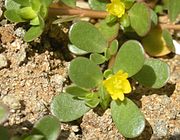Portulaca oleracea
From Wikipedia, the free encyclopedia
| Portulaca oleracea | ||||||||||||||
|---|---|---|---|---|---|---|---|---|---|---|---|---|---|---|
 |
||||||||||||||
| Scientific classification | ||||||||||||||
|
||||||||||||||
| Binomial name | ||||||||||||||
| Portulaca oleracea L. |
Portulaca oleracea (Common Purslane, also known as Verdolaga, Pigweed, Little Hogweed or Pusley), is an annual succulent in the family Portulacaceae, which can reach 40 cm in height. About 40 varieties are currently cultivated.[1] It has an extensive old-world distribution extending from North Africa through the Middle East and the Indian Subcontinent to Malesia and Australasia. The species status in the New World is uncertain: it is generally considered an exotic weed however there is evidence that the species was in Crawford Lake deposits (Ontario) in 1430-89, suggesting that it reached North America in the pre-Columbian era[2]. It is naturalised elsewhere and in some regions is considered an invasive weed. It has smooth, reddish, mostly prostrate stems and alternate leaves clustered at stem joints and ends. The yellow flowers have five regular parts and are up to 6 mm wide. The flowers appear depending upon rainfall and may occur year round. The flowers open singly at the center of the leaf cluster for only a few hours on sunny mornings. Seeds are formed in a tiny pod, which opens when the seeds are ready. Purslane has a taproot with fibrous secondary roots and is able to tolerate poor, compacted soils and drought.
Contents |
[edit] Culinary usage
Although purslane is considered a weed in the United States, it can be eaten as a leaf vegetable. It has a slightly sour and salty taste and is eaten throughout much of Europe, Asia and Mexico.[3][1] The stems, leaves and flower buds are all good to eat. Purslane can be used fresh as a salad, stir-fried, or cooked like spinach, and because of its mucilaginous quality it is also suitable for soups and stews. Australian Aborigines used to use the seeds to make seedcakes.
Purslane contains more Omega-3 fatty acids (alpha-linolenic acid in particular[4]) than any other leafy vegetable plant. Simopoulos states that Purslane has .01 mg/g of EPA. This is an extraordinary amount of EPA for land based vegetable sources. EPA is an Omega-3 fatty acid normally found mostly in fish, some algae and flax seeds. [5] It also contains vitamins (mainly vitamin A, vitamin C, and some vitamin B and carotenoids), as well as dietary minerals, such as magnesium, calcium, potassium and iron. Also present are two types of betalain alkaloid pigments, the reddish betacyanins (visible in the coloration of the stems) and the yellow betaxanthins (noticeable in the flowers and in the slight yellowish cast of the leaves). Both of these pigment types are potent antioxidants and have been found to have antimutagenic properties in laboratory studies.[6]
100 grams of fresh purslane leaves (about 1 cup) contain 300 to 400 mg of alpha-linolenic acid. One cup of cooked leaves contains 90 mg of calcium, 561 mg of potassium, and more than 2,000 IUs of vitamin A.
[edit] Medicinal usage
In Greek popular medicine, purslane is used as a remedy for constipation and inflammation of the urinary system. In antiquity its healing properties were thought so reliable that Pliny advised wearing the plant as an amulet to expel all evil (Natural History 20.120). [7]
[edit] History
Widely used in Greece, archaeobotanical finds are common at many prehistoric sites. In historic contexts, seeds have been retrieved from a protogeometric layer in Kastanas, as well as from the Samian Heraion dating to 7th century BC. Theophrastus in the 4th century BC names purslane, andrákhne, as one of the several summer pot herbs that must be sown in April (H.P 7.12).[7]
Known as "Sanhti or Punarva" in North India it is known to act as a liver tonic and is used in diseases of the liver[citation needed]. This green is also known as "kulfa",a common green in parts of India.
Known as Ma Chi Xian (pinyin: translates literally as "horse tooth amaranth") in Traditional Chinese Medicine, it is used to treat infections or bleeding of the genito-urinary tract as well as dysentery. The fresh herb may also be applied topically to relieve sores and insect or snake bites on the skin.[8]
[edit] Gallery
[edit] References
- ^ a b Marlena Spieler (July 5, 2006). "Something Tasty? Just Look Down". The New York Times. http://query.nytimes.com/gst/fullpage.html?res=9902E3DB1230F936A35754C0A9609C8B63.
- ^ Byrne, R. and McAndrews, J. H. (1975). "Pre-Columbian puslane (Portulaca oleracea L.) in the New World". Nature 253: 726–727. doi:.
- ^ Pests in Landscapes and Gardens: Common Purslane. Pest Notes University of California Agriculture and Natural Resources Publication 7461. October 2003
- ^ David Beaulieu. "Edible Landscaping With Purslane". About.com. http://landscaping.about.com/cs/weedsdiseases/a/purslane.htm.
- ^ ARTEMIS P SIMOPOULOS Omega-3 Fatty Acids and Antioxidants in Edible Wild Plants. 2004. Biol Res 37: 263-277, 2004
- ^ Evaluation of the Antimutagenic Activity of Different Vegetable Extracts Using an In Vitro Screening Test
- ^ a b Megaloudi, Fragiska (2005). Wild and Cultivated Vegetables, Herbs and Spices in Greek Antiquity. Environmental Archaeology 10 (1): 73-82
- ^ Bensky, Dan, et al. Chinese Herbal Medicine, Materia Medica. China: Eastland Press Inc., 2004.
[edit] External links
| Wikimedia Commons has media related to: Portulaca oleracea |
| Wikispecies has information related to: Portulaca oleracea |
- "Portulaca oleracea". FloraBase. Department of Environment and Conservation, Government of Western Australia. http://florabase.dec.wa.gov.au/browse/profile/2884.




